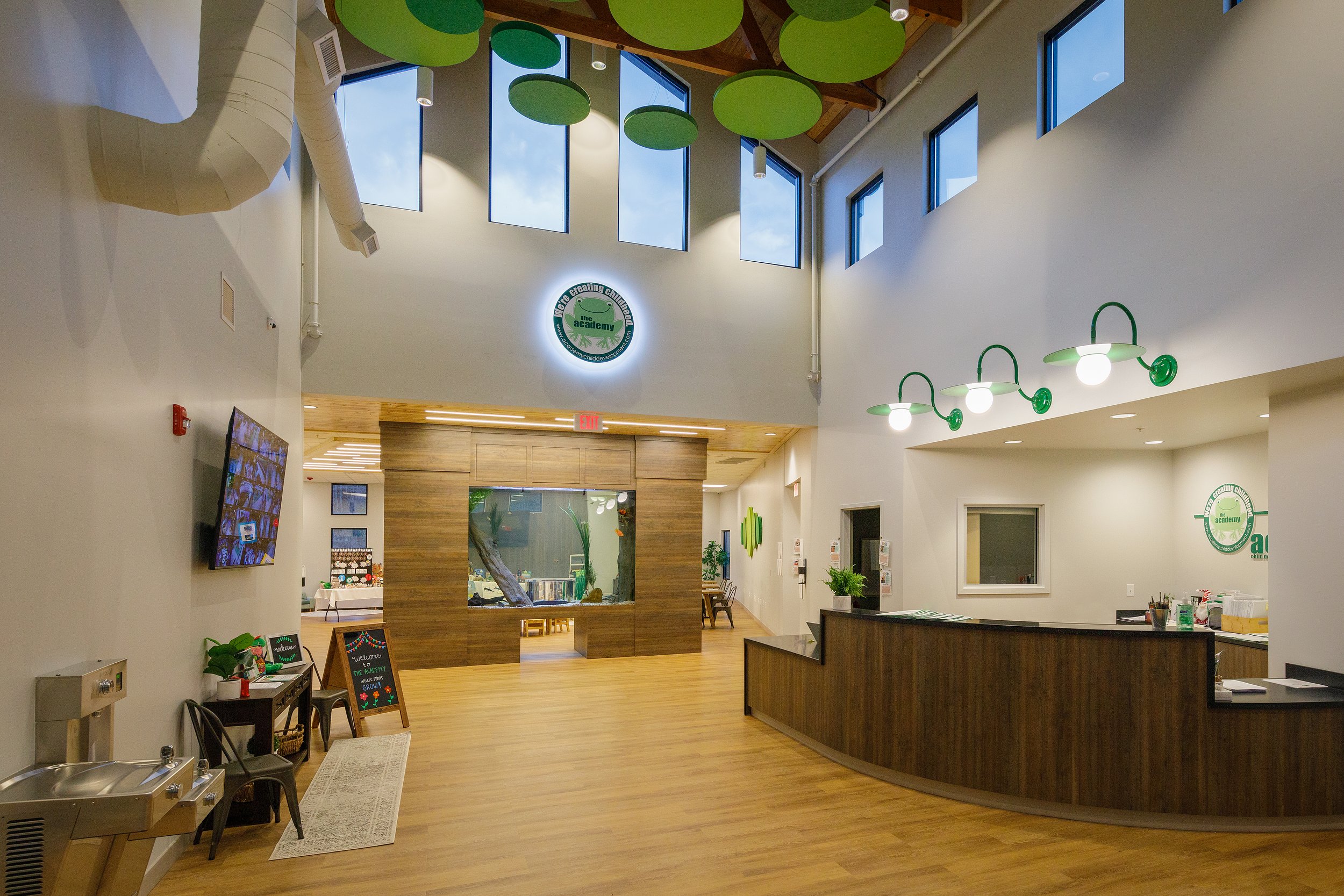Safety and security are of utmost importance. Paired with functional design that encourages learning, these attributes can transform a daycare into something more.
One may have noticed new preschools and childcare centers popping up around town recently. Not surprisingly, the need for such facilities has grown exponentially in the last few years, with young families placing higher importance on early childhood development and more parents heading back to the office post-COVID. According to the Bureau of Labor Statistics, preschools and similar early childcare facilities are booming, and teachers are in demand, citing that the position is “projected to grow 15% from 2021 to 2031, which is much faster than the average…” (“Preschool Teachers Occupational Outlook Handbook.”). Here at KSA, we have had the privilege of designing several unique childcare centers, with several more prototype designs on the horizon.
There’s a certain amount of intention that goes into designing a facility that is focused on child care. Perhaps the most important is the heightened importance of child and teacher safety, as well as the desire for a usable space to support the curriculum taught to the various age groups of enrolled students. These childcare centers open up a new, dynamic sector of innovation and flexibility in the architecture and design world – one that prioritizes learning, adventure, and security all under one roof.
The Academy at McCrory Lane - Nashville, TN
SAFETY
Safety plays a huge role in how new daycares and childcare centers are constructed today. Allowing our future generations to learn and play in a space built for their security is one of the foundational ideologies KSA adheres to in initial planning.
This key feature is first noticeable from the outside of the building, where strategically placed fencing and numerous safety gates segment the play areas into manageable spaces for one or more teachers to supervise. Another ideology used to enhance safety in these areas is the teachers’ line of sight – meaning the play areas are intentionally laid out to allow teachers to be able to see their students at all times from any point within that play space.
Learning Zone Smyrna - Smyrna, TN
Line of sight is also crucial in the classroom. To acknowledge this need, doors to closets, toilet rooms, and exterior exits are all laid out intentionally to allow the teachers to best see their students, even when helping one in the restroom or retrieving an item from the closet. “We [also] added a changing station in each classroom to help the teacher(s) continue to keep an eye on the whole class while tending to a child,” says David Mikhail (2023). David is KSA’s Project Manager heading up all daycare projects for the office. The changing stations are situated on a countertop facing toward the rest of the classroom, rather than against the wall. This ensures the teacher can adequately see all students at once, instead of forcing her to face away from them while changing a diaper.
No daycare facility is complete without germ-fighting surfaces, and KSA’s work is no different. Antimicrobial countertop surfaces and wipeable wall paint are just a few of the materials used to promote a clean and healthy environment for the children, their families, and the faculty utilizing the space. Durability plays a role too, which makes selecting finishes that can stand up to the stringent cleaning regimen and daily use even more crucial to the overall design.
The Academy of Forrest Crossing - Franklin, TN
DESIGN SUPPORTING CURRICULUM
Another key feature of a good childcare center is how well the overall design impacts, aids, and supports the curriculum enforced there. STEM/STEAM-focused curriculum is the foundation of The Learning Zone and The Academy daycares, which KSA carefully incorporates into every facility it designs for them. For those wondering: STEAM stands for Science, Technology, Engineering, Art, and Math. STEM just excludes Art. The Learning Zone Childcare website comments on their STEM/STEAM preschool curriculum: “Through this engaging and hands-on method, we encourage your children to explore, ask questions and discover through their own imagination, experiment, and of course, interactive play!” (“Preschool Smyrna TN, Daycare Smyrna TN | Learning Zone Child Care”).
Through the design primarily by utilizing a simple layout and specifying modern finishes, these tactics help to deliver a calming, neutral overall feel. Wood elements are intermittently dispersed throughout the space to incorporate a sense of grounding, and pops of color add variety. The facilities are laid out in a way that allows for simple wayfinding. Classrooms are organized by age group to promote a feeling of unity for the students. These ideas promote the curriculum by making strides to not impede learning or become a distraction. Instead, the simplistic environments allow for the children and their creations to be the artwork, color, and excitement throughout the facility!
Good team management is another key factor in proper function, which therefore supports the curriculum, by first supporting the faculty. “We add charging stations for the tablets the teachers use, which provide easy communication with the management team”, says Mikhail. (2023)
Unique signage placed throughout the school provides visuals of the pillars of learning that the daycares enforce in their curriculum, often sporting the individual daycare’s specialized branding. A specific example can be seen in The Learning Zone daycare, where classrooms are broken into ‘zones’ of learning, such as the expression zone, the action zone, the sensory zone, and more. Fun, gear-shaped signs denote these spaces and prove useful in creating specific activities or learning opportunities within each.
The Academy at Holly Tree Gap - Brentwood, TN
CONCLUSION
As daycares, preschools, and early childhood care centers continue to emerge in the Middle Tennessee area and beyond, it’s important to provide quality designs that support their unique goals. Safety and security are of utmost importance and functional design that encourages learning makes a daycare into something more. Giving our children a place to learn, grow, and play while being in a safe and comfortable environment has never been more important, and KSA is proud to be a part of this growing sector in the architectural and design world!
About the Author
Maureen Hittle, LEED Green Associate is an Interior Design Associate here at KSA. She is working toward her NCIDQ certification. A recent graduate of UT Chattanooga, she has designed several daycare facilities, schools, and multifamily developments.






